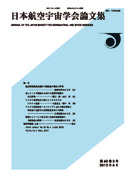
- Issue 2 Pages 21-
- Issue 1 Pages 1-
- |<
- <
- 1
- >
- >|
-
Yudai Okada, Koichi Yonezawa, Shigeru Sunada, Kohei Yamaguchi2024 Volume 72 Issue 1 Pages 1-10
Published: 2024
Released on J-STAGE: February 05, 2024
JOURNAL RESTRICTED ACCESSThe lateral/directional attitudes of small airplanes are easily disturbed by crosswind in take-off or landing operations, because the flight velocities and moments of inertia are smaller than those of large airplanes. Although conventional airplanes mainly control their lateral/directional attitudes by using the control surfaces such as an aileron and a rudder, the moments generated by the control surfaces are not enough in low-flight-velocity conditions such as in take-off or landing operations. The present paper focuses on a control strategy using multiple tractor propellers for small airplanes to generate sufficient moments in the low-flight-velocity conditions. This method utilizes the thrusts of propellers and the effect of interaction between the propellers and the main wing in addition to control surfaces. The present paper confirmed this method approximately achieves to double the control moments compared with those just by the control surfaces and showed the relationship between the number of propellers and the control moments in this method.
View full abstractDownload PDF (1068K) -
Masashi Shigemi, Midori Maki2024 Volume 72 Issue 1 Pages 11-20
Published: 2024
Released on J-STAGE: February 05, 2024
JOURNAL RESTRICTED ACCESSThroughout the history of flight motion analysis, atmospheric disturbances have been stochastic colored noise with certain spectral characteristics. On the other hand, various terrain turbulences such as mountain waves, or clear-air-turbulence are more faithful to real meteorological phenomena when represented as a single or multiple vortex structure. In this study, we present an extension of the classical panel method to compute in practical time the aerodynamic six forces and moments acting on an aircraft in a turbulent field represented by a superposition of line vortices. By changing the number and combination of vortices, various types of turbulence can be generated around the aircraft. As a practical approximate calculation method for the flow field around an aircraft in turbulent air, this method is expected to be a simple alternative to CFD, which inevitably involves huge computational costs. The method can be extended to compressible flows as well. Three numerical examples are presented to demonstrate the reliability of the proposed method.
View full abstractDownload PDF (1914K)
- |<
- <
- 1
- >
- >|